While wind and solar are offering more energy than ever to global grids, there is still much work to be done if we want to properly integrate them; one question that always arise is that of energy storage. Sure, you can harvest a lot of sun during the day, but you need to store it for later usage, and that’s quite a problem. Now, a Canadian start-up believe they may have found a solution for that, and it’s just crazy enough to work: underwater balloons.
Here’s a video showing how it would work:
Hydrostor was founded in Toronto, Canada with the goal of creating the world’s first underwater compressed air energy storage system and demonstrating this technique’s utility. According to them, their way can last twice as long as the best batteries we have today, and at a much lower cost. The first facility has already been set up in Lake Ontario near Toronto, with a series of balloons set 55 metres under the surface of the water and connected to the power grid via a pipeline.
The idea of using compressed air to store energy is not new at all though.
“Compressed air’s been around for 40 years,” Hydrostor CEO Curtis VanWalleghem said in an interview. “It’s finding places to store the air that’s been the problem [and] why it hasn’t been massively adopted. We open it up to thousands more sites because we use hydrostatic water pressure.”

The basic principle is fairly simple – you take the excess energy and convert it into compressed air, while the heat generated in the process is stored as well through heat exchangers. When needed, the natural pressure of the lake is used to pump the air back to land driving a turbine and generating electricity as it goes. The balloons in Lake Ontario are capable of holding enough energy to power 330 homes, but this is just a proof of concept – it can easily be scaled up.
“We’re now focused on commercialising this technology globally to bring our green energy storage solution to countries around the world,” Vsaid VanWalleghem. “The G20 is talking about getting off fossil fuel by 2050. To do that, our electricity system has to incorporate storage so we don’t need as much backup diesel and natural gas capacity – that’s what this can do.”
There are quite a few advantages to this technology (small land footprint, very high efficiency, quite flexible), but of course there are hurdles; first of all, the price. I haven’t found any official figures for the cost, but I assume it’s quite a hefty price tag. Also, I imagine there’s a big waiting time before the initial energy is transferred, and then retransferred, which could cause some availability issues – but this is definitely an extremely interesting technology, and one that I really look forward to in the future.



